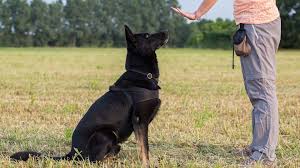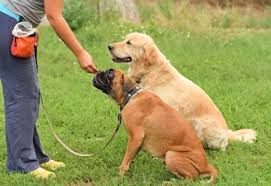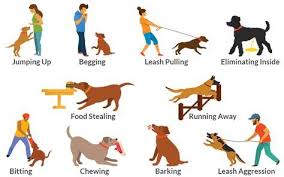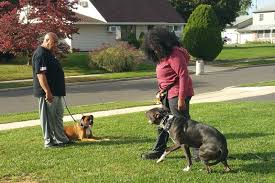Dogs training and behavior are essential components of responsible pet ownership. Understanding how to train a dog effectively not only helps create a well-behaved companion but also strengthens the bond between the dog and its owner.
Training provides dogs with the necessary skills to navigate their environment safely and comfortably, making it easier for them to coexist with humans and other animals. Additionally, training can significantly reduce problematic behaviors, such as excessive barking, chewing, or aggression, leading to a more harmonious household.
The process of training a dog involves teaching commands, encouraging desired behaviors, and discouraging undesirable ones through various techniques and strategies. While training methods can vary, they often center around the principles of positive reinforcement, which emphasizes rewarding good behavior rather than punishing bad behavior.
This approach not only motivates dogs to learn but also fosters trust and confidence between the dog and its owner.
Behavior is a critical aspect of dog training. Each dog has its unique personality and temperament, influenced by factors such as breed, age, and individual experiences. Understanding these behavioral traits is crucial for developing effective training strategies.
For instance, some breeds may be more eager to please, while others might be more independent or stubborn. Recognizing these differences allows owners to tailor their training methods to fit their dog’s needs, ensuring a more productive training experience.
Socialization is another vital element in a dog’s training and behavior. Introducing a dog to various environments, people, and other animals helps it develop confidence and adaptability. Proper socialization can prevent behavioral issues, such as fearfulness or aggression, and promote a well-rounded, balanced dog.
It is crucial to expose dogs to diverse experiences during their early developmental stages, ideally between the ages of 3 to 14 weeks, to lay the foundation for good behavior throughout their lives.
Training should also be an ongoing process. Dogs are always learning, and consistent reinforcement of commands and behaviors is key to maintaining good habits.
Regular practice, along with continued exposure to new experiences and challenges, keeps a dog mentally stimulated and engaged. This ongoing training helps to reinforce the bond between the dog and its owner, fostering a sense of teamwork and mutual respect.
In addition to basic obedience training, addressing specific behavioral issues is an important part of responsible dog ownership. Many dog owners may encounter problems such as separation anxiety, fear of loud noises, or aggression towards other animals or people.
Understanding the underlying causes of these behaviors is essential for implementing effective training solutions. Seeking guidance from a professional dog trainer or behaviorist can be beneficial in addressing these issues, providing owners with the tools and techniques needed to help their dogs overcome challenges.
Ultimately, dog training and behavior are interconnected aspects of pet ownership that require patience, consistency, and dedication.
By investing time and effort into training, dog owners can ensure their pets grow into well-mannered and confident companions, enriching both their lives and the lives of those around them. With the right approach, dog training can be a rewarding and enjoyable experience for both the dog and the owner.
Understanding Dog Behavior

Understanding dog behavior is the foundation for successful training and communication. Here are key concepts to consider:
1. Communication: Dogs communicate through body language, vocalizations, and behaviors. Learning to interpret these signals can help you understand your dog’s needs and emotions.
2. Socialization: Dogs are social animals that thrive on interaction. Early socialization with different people, pets, and environments can help reduce anxiety and aggression.
3. Instincts: Dogs have natural instincts influenced by their breed. For example, herding dogs may exhibit behaviors related to herding, while hunting breeds may have a strong prey drive.
4. Learning Styles: Each dog has a unique learning style. Some dogs may respond better to visual cues, while others may be more motivated by verbal praise or treats.
5. Environment: A dog’s environment can significantly impact their behavior. Factors such as noise, other animals, and human interactions can lead to stress or anxiety in dogs.
The Importance of Training Your Dog
Training your dog is essential for various reasons:
1. Safety: Training helps ensure your dog’s safety and the safety of others. Commands like “sit,” “stay,” and “come” can prevent dangerous situations.
2. Socialization: Proper training promotes good behavior around other dogs and people, reducing the likelihood of aggressive or fearful reactions.
3. Bonding: Training sessions strengthen the bond between you and your dog. It provides opportunities for positive interactions and shared experiences.
4. Mental Stimulation: Training challenges your dog’s mind, keeping them engaged and preventing boredom, which can lead to destructive behaviors.
5. Confidence Building: A well-trained dog feels more secure in their environment. Confidence-building exercises help your dog become more adaptable to new situations.
Read Also: Feijoas: History, Nutrition, Health Benefits and Growing Guide
Basic Commands Every Dog Should Know

Teaching your dog basic commands is fundamental for good behavior. Here are essential commands to start with:
1. Sit: This command teaches your dog to sit on command. It’s a great way to gain control in various situations.
2. Stay: Teaching your dog to stay in place helps with impulse control and prevents them from running off or getting into trouble.
3. Come: The “come” command is vital for recall. It ensures your dog returns to you when called, which is essential for their safety.
4. Down: This command helps your dog learn to lie down, which can be calming in exciting situations.
5. Leave it: Teaching “leave it” helps your dog learn to ignore distractions or unwanted items, promoting safer behaviors.
Positive Reinforcement Techniques
Positive reinforcement is a powerful training method that encourages desired behaviors. Here’s how to effectively use it:
1. Rewards: Use treats, praise, or toys as rewards for good behavior. This encourages your dog to repeat the desired action.
2. Timing: Provide rewards immediately after your dog performs the desired behavior. This helps them associate the action with the reward.
3. Consistency: Be consistent with your commands and rewards. Using the same words and gestures helps your dog understand what you expect.
4. Patience: Training takes time and patience. Celebrate small successes, and don’t rush the process. Every dog learns at their own pace.
5. Avoid Punishment: Focus on reinforcing positive behaviors rather than punishing negative ones. Punishment can lead to fear and anxiety, hindering the training process.
Importance of Socialization
Socialization is essential for several reasons:
1. Reduces Fear and Anxiety: Proper socialization helps dogs feel more comfortable in new situations, reducing fear and anxiety. Dogs that are well-socialized are less likely to react negatively to unfamiliar experiences.
2. Encourages Positive Behavior: Exposing your dog to various people, animals, and environments encourages positive behaviors. Socialized dogs are often more friendly and less aggressive.
3. Enhances Adaptability: Well-socialized dogs are more adaptable and can handle changes in their environment more easily. This adaptability is beneficial for travel, vet visits, and other changes.
4. Strengthens Bonds: Socialization fosters stronger bonds between you and your dog. Positive experiences together create trust and enhance your relationship.
Read Also: Trichomoniasis: Description, Damages Caused, Control and Preventive Measures
Addressing Common Behavioral Issues

Behavioral issues can arise if a dog is not properly socialized. Here are common problems and how to address them:
1. Aggression: Dogs that have not been socialized may display aggressive behaviors toward other dogs or people. Gradual exposure to new experiences, along with positive reinforcement, can help mitigate aggression.
2. Fearfulness: Fearful dogs may react with barking, growling, or hiding. Socialization can help reduce fear by gradually introducing them to new environments and experiences in a controlled manner.
3. Destructive Behavior: Dogs that lack socialization may become bored or anxious, leading to destructive behaviors such as chewing furniture. Providing regular socialization opportunities and mental stimulation can help alleviate this issue.
4. Separation Anxiety: Unfamiliar situations can lead to separation anxiety. Socializing your dog helps them learn that new experiences can be positive, making them more comfortable when left alone.
The Role of Consistency in Training
Consistency is vital in dog training. Here’s why:
1. Clear Expectations: Consistent training establishes clear expectations for your dog. Using the same commands and cues helps your dog understand what you want from them.
2. Builds Trust: Consistency in your training methods builds trust between you and your dog. Dogs feel secure when they know what to expect from their owner.
3. Reduces Confusion: Inconsistent commands or training methods can confuse your dog, making it harder for them to learn. Consistency helps reinforce the desired behaviors.
4. Encourages Good Habits: Regular and consistent training sessions help reinforce good habits, leading to long-term success in your dog’s behavior.
Training Methods: Choosing What Works Best
There are various training methods available, and finding the right one for your dog is essential. Here are some popular approaches:
1. Positive Reinforcement: This method involves rewarding your dog for desired behaviors using treats, praise, or toys. Positive reinforcement is effective for building a strong bond and encouraging good behavior.
2. Clicker Training: Clicker training uses a small device that makes a clicking sound to mark desired behaviors. The sound is followed by a reward, helping your dog associate the behavior with the click.
3. Obedience Classes: Enrolling your dog in obedience classes provides structured training and socialization opportunities. These classes often cover essential commands and address behavioral issues.
4. Socialization Classes: These classes focus specifically on exposing your dog to different environments, people, and other animals. Socialization classes can help reduce fear and build confidence.
5. Training Videos and Online Resources: Many dog trainers offer online resources and videos to help you train your dog at home. These can be useful for learning new techniques and addressing specific issues.
Understanding Your Dog’s Body Language
Dog body language can be subtle, but it offers valuable insights into your dog’s feelings and intentions. Here are some key signals to recognize:
1. Tail Position: A wagging tail can indicate excitement, while a lowered tail may suggest fear or submission. A stiff, high tail can signify alertness or aggression.
2. Ear Position: Ears held high and forward show curiosity or excitement, while ears laid back can indicate fear or submission. Ears that are relaxed often mean the dog is calm.
3. Eye Contact: Direct eye contact can signal aggression, while soft, relaxed eyes indicate comfort. Averted eyes or looking away can suggest a desire to avoid confrontation.
4. Body Posture: A relaxed body posture means your dog is comfortable, while a tense body can indicate stress or anxiety. A dog that turns sideways may be trying to show submission.
5. Facial Expressions: Dogs use their mouths and faces to communicate. A relaxed mouth indicates comfort, while a tightly closed mouth or bared teeth can signify discomfort or aggression.
Advanced Training Techniques
Once your dog has mastered basic commands, you may want to explore advanced training techniques to further enhance their skills. Here are some effective methods:
1. Agility Training: Agility training involves navigating an obstacle course. This activity enhances your dog’s physical fitness and strengthens the bond between you and your dog.
2. Trick Training: Teaching your dog fun tricks, such as rolling over or playing dead, stimulates their mind and provides an excellent opportunity for bonding and positive reinforcement.
3. Scent Work: Engaging your dog’s sense of smell through scent work challenges them mentally. You can start with simple hide-and-seek games using their favorite treats.
4. Impulse Control Exercises: Techniques like “leave it” and “wait” help improve your dog’s impulse control, leading to better behavior in various situations.
5. Clicker Training for Advanced Commands: Use clicker training to teach more complex commands or behaviors. This method helps reinforce learning through immediate rewards.
The Importance of Exercise for Behavior Management
Regular exercise is crucial for your dog’s physical and mental well-being. Here’s why exercise matters:
1. Reduces Anxiety and Stress: Physical activity releases endorphins, helping to reduce anxiety and stress levels in dogs. A well-exercised dog is often calmer and more content.
2. Prevents Destructive Behavior: Boredom and excess energy can lead to destructive behaviors. Regular exercise provides an outlet for your dog’s energy, minimizing the likelihood of issues like chewing or digging.
3. Enhances Socialization: Exercise often involves interactions with other dogs and people, promoting social skills and confidence. Playtime at dog parks or during walks encourages positive behaviors.
4. Improves Obedience: A tired dog is generally more focused and attentive, making training sessions more effective. Regular exercise can enhance your dog’s ability to learn and retain commands.
5. Promotes Healthy Weight: Maintaining a healthy weight through regular exercise is vital for your dog’s overall health and longevity. It helps prevent obesity-related health issues.
When to Seek Professional Help in Dog Training
While many dog training issues can be addressed at home, there are situations where professional help is necessary. Here are some signs that it may be time to consult a trainer:
1. Persistent Behavioral Issues: If your dog displays persistent behavioral problems, such as aggression, excessive barking, or anxiety, a professional trainer can provide targeted strategies to address these issues.
2. Lack of Progress: If you’ve been training your dog for a while without noticeable improvement, seeking professional guidance can offer new techniques and perspectives.
3. Special Needs or Conditions: Dogs with special needs or behavioral conditions may require specialized training methods. Professionals with experience in these areas can help tailor a training plan.
4. Overwhelming Situations: If you feel overwhelmed or unsure about how to handle your dog’s behavior, a professional can provide support and guidance, ensuring you feel confident in your training efforts.
5. Safety Concerns: If your dog displays aggressive behavior towards people or other animals, it’s essential to seek professional help immediately to ensure the safety of everyone involved.
Do you have any questions, suggestions, or contributions? If so, please feel free to use the comment box below to share your thoughts. We also encourage you to kindly share this information with others who might benefit from it. Since we can’t reach everyone at once, we truly appreciate your help in spreading the word. Thank you so much for your support and for sharing!
Read Also: Top 20 Proven Benefits of Ginger Plant

